Add this eBook to your basket to receive access to all 2,339 records. Our indexes include entries for the spelling booth. In the period you have requested, we have the following 2,339 records (displaying 1,621 to 1,630): These sample scans are from the original record. You will get scans of the full pages or articles where the surname you searched for has been found. Your web browser may prevent the sample windows from opening; in this case please change your browser settings to allow pop-up windows from this site. Boys entering Marlborough College
(1869)
The public school at Marlborough in Wiltshire was founded in 1843. In 1952 this, 9th, edition of the college register was published, being a revision by L. Warwick James of the 8th edition (of 1936): but for the years before 1936 it does not merely repeat the 8th edition, because Warwick James was able to correct the 19th-century entries with information from newly-discovered letters and books from 1843 to 1853, and the school lists from 1844 onwards. The roll is arranged by year, and within each year by term of entrance, and then alphabetically by surname within each term. Each boy is assigned a number within the year: then his name is given, surname first, and, in brackets, where a boarder, his house. The houses within the college were called B1, B2, B3, C1, C2 and C3, and the Lower School (L Sch); the out college houses were Preshute, Priory, Cotton, Hermitage, Littlefield, Barton Hill, Summerfield and Upcot. Then there is given the boy's father's name (surname and initials) and address (at entrance), the boy's date of birth (b) and month of leaving (l). Where the boy represented the school at Rugby football (XV) or cricket (XI), in the rifle corps (VIII, or RC XI), that is indicated. There is a brief summary of achievements in later life, and, where known, and date of death or (in italics) address as in 1952. | Sample scan, click to enlarge
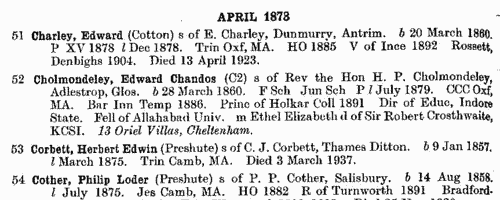
| Deaths
(1869)
Deaths reported in the Pall Mall Gazette, May 1869 | Sample scan, click to enlarge

| Members of the Association for Promoting the Extension of The Contagious Diseases Act, in Birmingham
(1869)
The Contagious Diseases Act of 1866 had as its first objective the establishment of isolation hospitals for the treatment of soldiers and sailors afflicted with smallpox, typhoid, measles, chicken pox, malaria, scarlet fever, bubonic plague, dysentery, enteric fever and other infectious conditions. This association was formed to lobby for the extension of the Act to the civil population of the United Kingdom. The membership was drawn not just from the medical profession and those interested in the administration of the poor law, but also from concerned individuals throughout society. The membership list was published alphabetically by area: the scan shows the start of the names for Leicester. | Sample scan, click to enlarge
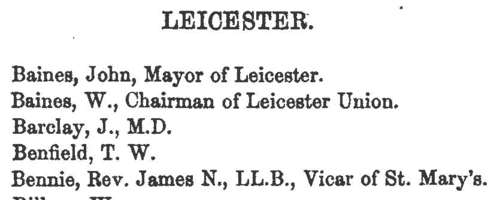
| Patentees of New Inventions
(1869)
Index of patentees and applicants for patents of inventions in 1869: giving full name of patentee (surname first); number of patent (in bold); date (within 1869); and subject-matter. Where the patentee was acting as agent for third parties, their names are given in italics in the subject-matter column. | Sample scan, click to enlarge

| Science Schools and Classes: Elementary Examination: Class Lists
(1869)
The Science and Art Department of the Committee of Council on Education published these class lists giving the names of all the successful candidates in the examination of science schools and classes taken in May 1869. The candidates were of three levels: honours; second stage or advanced examination; third stage or elementary examination. Twenty-three subjects were offered. These are the lists for the elementary examination. The tables, arranged subject by subject, give the candidate's full name (surname first), age, and occupation - or, in the case of those not yet of working age, father's occupation, preceded by (f.). Many candidates sat and were successful in more than one subject, and so appear in more than one list. The subjects are: I. Practical, Plane and Solid Geometry; II. Machine Construction; III. Building Construction; IV. Elementary Mathematics; V. Higher Mathematics; VI. Theoretical Mechanics; VII. Applied Mechanics; VIII. Acoustics, Light, and Heat: IX. Magnetism and Electricity; X. Inorganic Chemistry; XI. Organic Chemistry; XII. Geology; XIII. Mineralogy; XIV. Animal Physiology; XV. Zoology; XVI. Vegetable Anatomy and Physiology; XVII. Systematic and Economic Botany; XVIII. Mining; XIX. Metallurgy; XX. Navigation; XXI. Nautical Astronomy; XXII. Steam; XXIII. Physical Geography. | Sample scan, click to enlarge

| Science Schools and Classes: Honours and Advanced Examinations: Class Lists
(1869)
The Science and Art Department of the Committee of Council on Education published these class lists giving the names of all the successful candidates in the examination of science schools and classes taken in May 1869. The candidates were of three levels: honours; second stage or advanced examination; third stage or elementary examination. Twenty-three subjects were offered. These are the lists for the honours and advanced examinations. The tables, arranged subject by subject, give the candidate's full name (surname first), age, and occupation - or, in the case of those not yet of working age, father's occupation, preceded by (f.); the name of the school where the candidate was taught the subject; and the name of the teacher. Many candidates sat and were successful in more than one subject, and so appear in more than one list. The subjects are: I. Practical, Plane and Solid Geometry; II. Machine Construction; III. Building Construction; IV. Elementary Mathematics; V. Higher Mathematics; VI. Theoretical Mechanics; VII. Applied Mechanics; VIII. Acoustics, Light, and Heat: IX. Magnetism and Electricity; X. Inorganic Chemistry; XI. Organic Chemistry; XII. Geology; XIII. Mineralogy; XIV. Animal Physiology; XV. Zoology; XVI. Vegetable Anatomy and Physiology; XVII. Systematic and Economic Botany; XVIII. Mining; XIX. Metallurgy; XX. Navigation; XXI. Nautical Astronomy; XXII. Steam; XXIII. Physical Geography. | Sample scan, click to enlarge

|  Outstanding soldiers of the 22nd regiment of Foot
(1860-1870) Outstanding soldiers of the 22nd regiment of Foot
(1860-1870)
The 22nd (The Cheshire) Regiment of Foot was in two battalions. The 1st battalion returned to England from India in 1855: the depot was at Parkhurst. In 1869 the battalion was moved to India. The second battalion was also based at Parkhurst, and was sent to Malta in 1859; in July 1865 it was sent to Gibraltar, but the same month redirected to the Mauritius, returning to England in July 1867. Each year just a handful of outstanding soldiers of the regiment were chosen for good conduct medals and gratuities: these are listed here. There were two lists, one for men recommended for the Good Conduct Medal without a gratuity, and one for gratuities - £5 to a private, £10 to a corporal, and £15 to a serjeant. Both lists are indexed here, and each gives rank, name, regimental number, date of recommendation and date of issue. (The sample scan is from the 105th foot) | Sample scan, click to enlarge
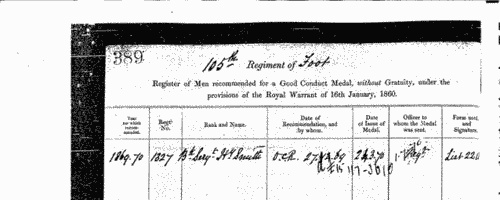
|  Outstanding soldiers of the 26th regiment of Foot
(1860-1870) Outstanding soldiers of the 26th regiment of Foot
(1860-1870)
The 26th (The Cameronian) Regiment of Foot returned from Bermuda in 1859, and was at Dublin in 1860: the depot was at Belfast. In 1861 the regiment was moved to Scotland; in 1862 to England; and in 1865 to India. Each year just a handful of outstanding soldiers of the regiment were chosen for good conduct medals and gratuities: these are listed here. There were two lists, one for men recommended for the Good Conduct Medal without a gratuity, and one for gratuities - £5 to a private, £10 to a corporal, and £15 to a serjeant. Both lists are indexed here, and each gives rank, name, regimental number, date of recommendation and date of issue. (The sample scan is from the 105th foot) | Sample scan, click to enlarge
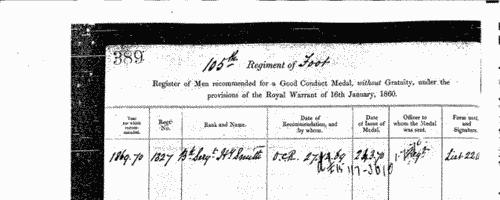
|  Outstanding soldiers of the 47th regiment of Foot
(1860-1870) Outstanding soldiers of the 47th regiment of Foot
(1860-1870)
The 47th (The Lancashire) Regiment of Foot returned from Gibraltar in 1857. It was serving at Shorncliffe in 1860. The regimental depot was at Cork. Each year just a handful of outstanding soldiers of the regiment were chosen for good conduct medals and gratuities: these are listed here. There were two lists, one for men recommended for the Good Conduct Medal without a gratuity, and one for gratuities - £5 to a private, £10 to a corporal, and £15 to a serjeant. Both lists are indexed here, and each gives rank, name, regimental number, date of recommendation and date of issue. (The sample scan is from the 105th foot) | Sample scan, click to enlarge
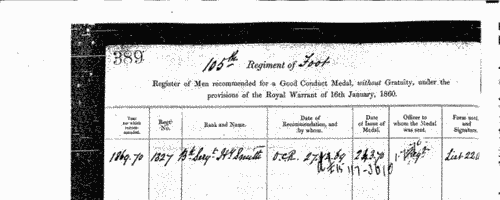
|  Outstanding soldiers of the 5th regiment of Lancers
(1860-1870) Outstanding soldiers of the 5th regiment of Lancers
(1860-1870)
The 5th (Royal Irish) Regiment of Light Dragoons, or Lancers, was at headquarters at Newbridge in 1860. Each year just a handful of outstanding soldiers of the regiment were chosen for good conduct medals and gratuities: these are listed here. There were two lists, one for men recommended for the Good Conduct Medal without a gratuity, and one for gratuities - £5 to a private, £10 to a corporal, and £15 to a serjeant. Both lists are indexed here, and each gives rank, name, regimental number, date of recommendation and date of issue. (The sample scan is from the 105th foot) | Sample scan, click to enlarge
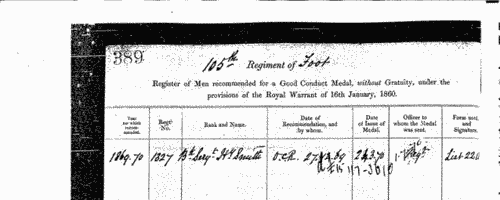
|
Research your ancestry, family history, genealogy and one-name study by direct access to original records and archives indexed by surname.
|












